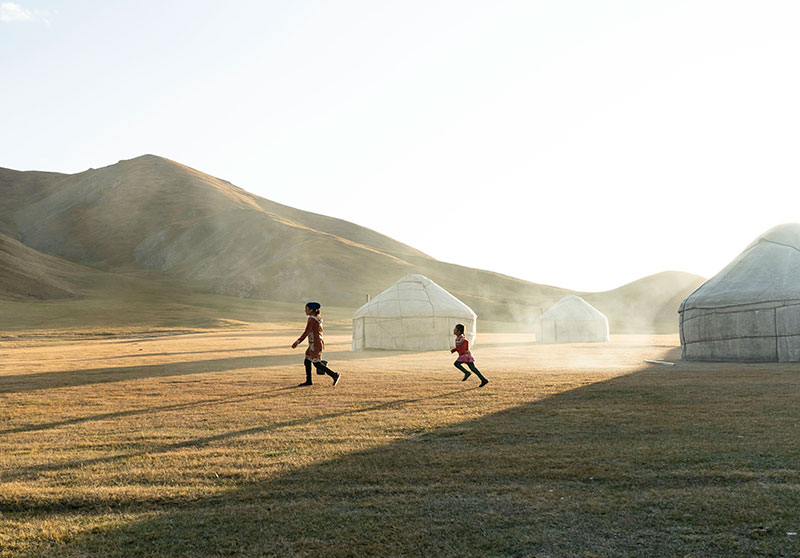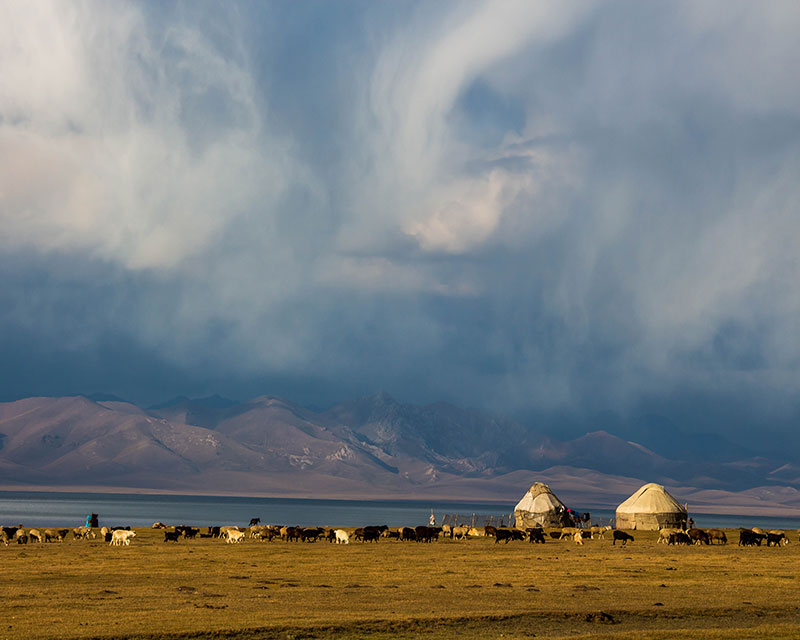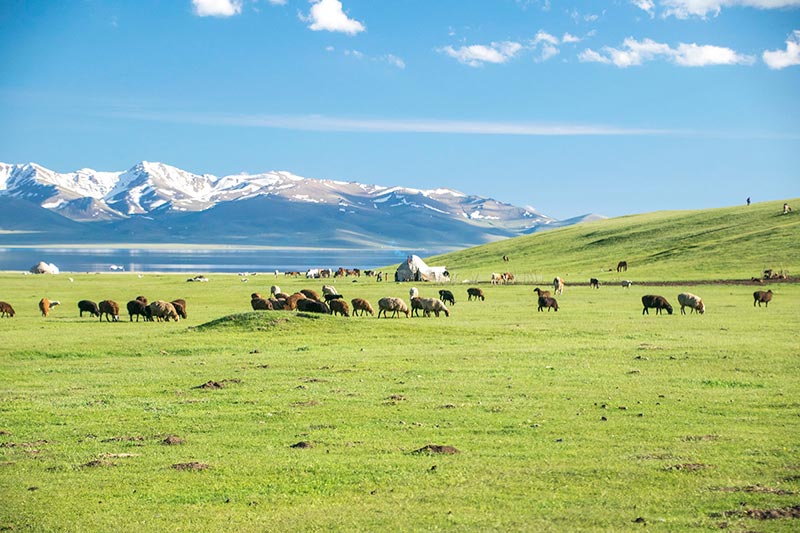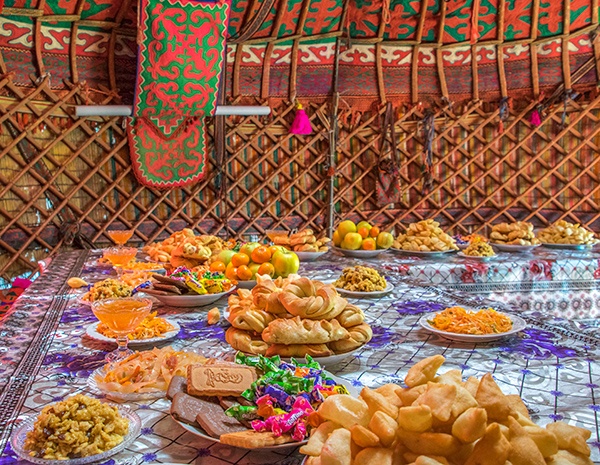APRIL 3, 2021 BY TEH CHIN LIANG
Interviewing Aisha Mambetalieva is similar to wearing a Virtual Reality headset and going on a virtual tour around the highlands of Kyrgyzstan. Her passion for the history and tradition of the Kyrgyz nomads is contagious. Through her enthusiasm and lively narration, she transported me through the nomadic lands of Kyrgyzstan.
I imagined myself standing in a green alpine pasture. I was surrounded by unspoiled and majestic mountains in the distance. Horse tracks led me to a clearing surrounded by yurts. Approaching a yurt, I gently lifted the curtain covering the front door and ducked my head to get through the door – ready to meet the local nomads, hear about their lives and try their foods.
Q: Tell us what you know about the nomads in Kyrgyzstan?
The Kyrgyz are descendants of the ancient Turks. They became sedentary in the late 19th or early 20th century. To this day, semi-nomadic life still predominates in some regions of the country. These people migrate to the summer pastures with their livestock that are used to fertilize the alpine meadows. My grand-grandparents are nomads.
The nomads live with the concept of genuine hospitality. They welcome whoever passing by their yurts by offering them food such as white bread and drink like kymyz, ayran, chalap etc. Guests are invited to taste a bread (nan oozu tiyinyz) and stay for a meal with the family. It is a blessing for them to have guests at the house.

Q: What is one extraordinary aspect of a nomad’s life that you find fascinating and impressive?
Boz-Ui – Yurt – is a nomad’s dwelling. It is a symbol of home, peace and family. Yurt is a unique architectural construction that is made of kerege – walls, uuk – long sticks that supports the ceiling and tunduk – a wooden top of the yurt. The carcass of the yurt is layered with wool covers that act as an insulator to keep the interior cool in summer and warm in winter. A yurt can be easily put together within 30 minutes. It requires teamwork involving the whole family and community members.
The inner space of a yurt is divided into 3 sections. Upon entry there is tor – the very front of the yurt dedicating to honorable guests and elderly. When walking through the front door, one will have to bow in showing respect to them. The left side of the yurt is er jak – the men’s chamber and right side is epchi jak- women’s chamber with an adjoining chygdan – kitchen.
Q: How often do the nomads move from one place to another? Which parts in Kyrgyzstan do they normally settle down and build their temporary homes?
Usually twice a year. In winter, they move to the winter pastures at the foothills and in summer, they move to the to the highland pastures, jailoo – with succulent grass and space to tend to their livestock.
The nomads used to live by strict rules and rituals. In older days, the koch (migration) was always planned in advance. The migration timing is determined by the star observation and changes in weather. Nowadays, the migration is seasonal, they move to summer pastures in spring, which is around April and move back to the highland pastures in winter, normally in September.
All the pastures in mountainous regions are occupied by shepherds in summer. The famous pastures in Naryn region are Son-Kol Lake, Kara-Kujur, Syrt, Arpa, Ak-Sai. Each oblast has its own highland pastures.

Q: With the booming growth of technology and social media, have you seen a rush of modernization in their lifestyle, or most of them still stay true to their traditional roots?
Of course, modernization process has altered the way of life for nomads. Some rural parts that were once cut off from the outside world now has cellular coverage.
Some of the summer pastures are installed with warm water and lights powered by solar panels. The quality of life has certainly improved. Another pressing issue is the ecology and environmental protection. More and more questions are raised concerning the sustainable development in all regions.
Q: Where is the perfect place in Kyrgyzstan for a visitor to get the best experience living with nomadic people?
Tourists can experience nomadic life in Jailoo, for example, Son-Kol Lake. Most visitors stay at the yurts with local shepherds, as it was the only accommodation option in the mountains. Some tourists choose to camp near the yurts, that way they can get closer with the nomads and see them go about their daily lives.
Bear in mind that at an elevation of 3000 meters from sea level, one can easily come down with altitude sickness. So, always be well-prepared to deal with such circumstances.
Nowadays, local shepherds and tour operators put up additional yurts to provide homestay for tourists. This new business opportunity opens the doors of entrepreneurship to the nomads especially women to run their own yurt stay business.

Q: Kymyz, the fermented mare milk is a natural laxative that most of the visitors are not aware of. Can you shed some light on this?
Kymyz is sour milk made from the fermentation process. Fresh mare’s milk is diluted and readily fermented. Kymyz is beaten in a cauldron for 24 hours. A sour yet refreshing nomadic drink is produced from the chemistry reaction and fermentation. Into the first 3-4 hours of fermentation, a soft non-alcoholic byproduct drink named saamal comes out and is served as a beverage for the family.
It is a routine for the nomads to drink warm steamed mare’s milk 5 times a day. Mares are milked five times a day. Steamed milk is believed to have a relaxation effect on intestines and help to cure various liver and lung ailments.
Kymyz has an unpleasant taste to many foreigners. Due to the relaxation effect, Kymyz causes diarrhea, which could lead the experience go downhill in an unexpected awkward way.
Q: To date, Kyrgyzstan has been the only country to host the World Nomad Games. In the daily life of nomads, what kind of sports or recreational activities that the nomads play?
Yes, indeed, Kyrgyzstan was the first country to organize the World Nomad Games. Nomad games take place throughout the year in Kyrgyzstan. Some games are only organized to mark a special occasion, for example, horse racing and equestrian sports. Some other sporting events are timed to certain holidays. Each game or activity has a deep significance that is passed on from one generation to another. Since the nomads live far from each other, every meeting, feast, or event is usually accompanied by friendly games and festivals community. Nomads live in a close-knit community, any significant events in life are celebrated together with close and distant relatives.
Q: In one of the Youtube videos I watched recently, most of the younger generation have moved to the city in search of a better life, leaving the elderly in the village. Is that the norm that you witness in Kyrgyzstan now? What is their family structure like?
The family structure of the Kyrgyz is patriarchal and very hierarchical. The family is ruled and headed by the eldest man in the family – the grandfather or father. Honoring the elders and helping the younger ones is one of the main rules in the family.
When a son gets married, he put up his own yurt next to his family. When a daughter is married away, she leaves home to join the new family. It is the way it has always been since ancient times.
The Kyrgyz never have orphanages for homeless kids or senior home for the elderly, as it is seen as a curse for the entire community to abandon their own children and the elderly. Divorce is also forbidden and is a disgrace for everyone.
Things have changed as time goes by. Nowadays, most children leave their parents’ home in search of a better life and work. Old parents stay in the village with grandchildren while their children earn a living in the city. Many rituals and traditions have changed over time, although some of them are making efforts to preserve the heritage of their ancestors.
Big events, celebrations and festivals are held with participation of family members, relatives and community people. They always stay true to their roots.
Q: What are the biggest challenges that nomadic people are facing right now?
The local pasture committees, an independent body, collects money from all the residents and help upgrade the living conditions by building infrastructures such as paved roads, garbage disposal, cleaning services etc. It is said that the committee, however, is not doing their job well enough to upkeep the facilities and cleanliness on the pastures.
In nomadic culture, it is a shame and a sign of disrespect to leave the pasture dirty with trash strewn around unattended. The Kyrgyz embrace a philosophy of living in harmony with nature and they worship the spirits of objects of nature such as mountains, river etc. Keeping the nature clean and green is always on top of their mind.
Q: What kind of food do they normally cook?
The traditional Kyrgyz cuisine is simple and fast to cook. The main Kyrgyz dish is Besh-Barmak, meaning five fingers, indicates that the dish is eaten with bare hands. Besh-Barmak is a dish consists of small chunks of chopped meat boiled in soup and served with homemade noodles.
Family mealtime is when everyone sits in a circle, the youngest son pours some warm water on the hands of people and ask for blessings. After a hot soup is served, everyone gets a part of the slaughtered animal (horse, cow, yak, sheep or goat).
After eating, everyone washes their hands with warm water and give blessings for each member of the family.

The Kyrgyz food mainly consists of meat. The meats are fried and smoked – tash-kordo. Boiled in spring water – besh-barmak and jerky meat – sursugon et
They also consume many dairy products – curds, cheese etc meal. With the influence of the Russian, Central Asia countries and other cuisines, today, the Kyrgyz cuisine is a blend of different elements and tastes.
Lastly, Aisha Mambetalieva welcomes you to visit Kyrgyzstan. As of this writing, visitors are required to have PCR test done 72 hours prior to their arrival in Kyrgyzstan.
All photographs credit: Myrzabek Ozubekov
Website: https://kyrgyzstan-tourism.com
Instagram: www.instagram.com/kyrgyzstan_tourism
